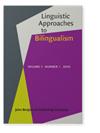双语父母儿童定向言语的特点
IF 1.8
2区 文学
0 LANGUAGE & LINGUISTICS
引用次数: 0
摘要
父母如何与年幼的孩子交谈对语言和认知发展至关重要。在早期,家庭中父母语言的数量、质量和多样性预测了词汇知识、入学准备和后期学业成绩的差异。然而,关于儿童定向言语(CDS)的研究大多来自于对单语父母的研究,而对双语父母的言语特征知之甚少。在这里,我们询问了单亲父母评估的双语程度是否与CDS特征呈正相关,已知CDS特征有助于儿童跨语言的词汇和语法结构——父母部分重复。在无脚本叙述期间(n = 91),据报道,双语更平衡的母亲在短时间内使用了更高比例的自我重复(包括单个单词和两个单词的组合)。同时,更多的双语母亲与更多的单语母亲保持着相同程度的词汇多样性。所获得的结果甚至考虑到了社会经济地位的差异。这些发现是从双语父母在双语语言发展中可能有意识或无意识地采取的适应策略的角度来讨论的本文章由计算机程序翻译,如有差异,请以英文原文为准。
Properties of child-directed speech in bilingual parents
How parents talk to young children matters to language and cognitive development. In the early years the quantity,
quality, and diversity inherent in language from parents in the home predict differences in vocabulary knowledge, school
readiness, and later academic achievement. However, most of what is known about child-directed speech (CDS) comes from studies of
monolingual parents, and little is known about features of speech from bilingual parents. Here, we asked whether degree of
bilingualism assessed within a single parent might be positively associated with CDS features that are known to facilitate
children’s lexical and grammatical structures across languages – parental partial repetitions. During unscripted narrations
(n = 91) of a picture book to their toddlers in English, mothers who reported being more bilingually balanced
used a higher proportion of self-repetitions (both single words and 2-word combinations) within a brief time-frame. At the same
time, more bilingual mothers preserved the same degree of lexical diversity as more monolingual mothers. The results obtained even
accounting for differences in socio-economic status. These findings are discussed in terms of adaptive strategies that bilingual
parents may consciously or unconsciously adopt in bilingual language development
求助全文
通过发布文献求助,成功后即可免费获取论文全文。
去求助
来源期刊

Linguistic Approaches To Bilingualism
Social Sciences-Linguistics and Language
CiteScore
3.20
自引率
9.10%
发文量
24
期刊介绍:
LAB provides an outlet for cutting-edge, contemporary studies on bilingualism. LAB assumes a broad definition of bilingualism, including: adult L2 acquisition, simultaneous child bilingualism, child L2 acquisition, adult heritage speaker competence, L1 attrition in L2/Ln environments, and adult L3/Ln acquisition. LAB solicits high quality articles of original research assuming any cognitive science approach to understanding the mental representation of bilingual language competence and performance, including cognitive linguistics, emergentism/connectionism, generative theories, psycholinguistic and processing accounts, and covering typical and atypical populations.
 求助内容:
求助内容: 应助结果提醒方式:
应助结果提醒方式:


